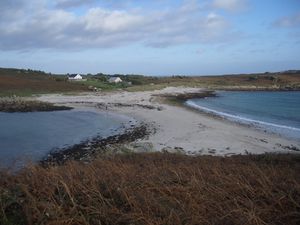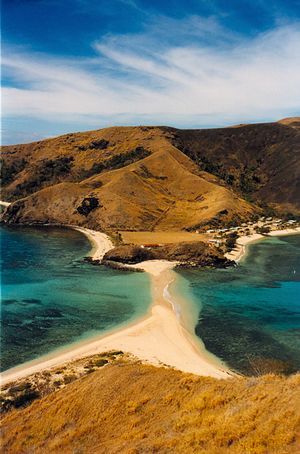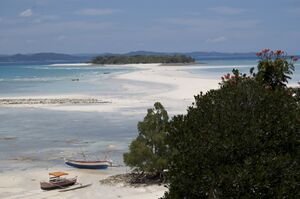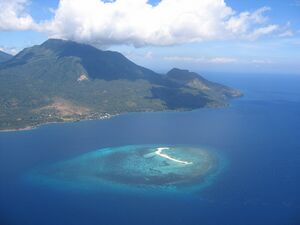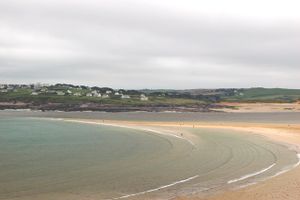ضحضاح
المياه الضحلة أو ضحضاح المياه[1] Shoal هي التي تتشكل من تراكم الرواسب الرملية في مصبات الأنهار أو علي الجروف القارية التي ربما تشكل خطر علي السفن. تعتبر المياه ضحلة عند الجروف القارية إذا كانت أقل من 10 متر (33 قدم) تحت سطح البحر أثناء الجزر، وتشكل العوامل التي تكون النبكات البحرية أيضا مياهً ضحلة.[2]
The term shoal is also used in a number of ways that can be either similar or quite different from how it is used in geologic, geomorphic, and oceanographic literature. Sometimes, this term refers to either any relatively shallow place in a stream, lake, sea, or other body of water; a rocky area on the seafloor within an area mapped for navigation purposes; or a growth of vegetation on the bottom of a deep lake that occurs at any depth or is used as a verb for the process of proceeding from a greater to a lesser depth of water.[3]
وصف
Shoals are characteristically long and narrow (linear) ridges. They can develop where a stream, river, or ocean current promotes deposition of sediment and granular material, resulting in localized shallowing (shoaling) of the water. Marine shoals also develop either by the in-place drowning of barrier islands as the result of episodic sea level rise or by the erosion and submergence of inactive delta lobes.
Shoals can appear as a coastal landform in the sea, where they are classified as a type of ocean bank, or as fluvial landforms in rivers, streams, and lakes.
A shoal–sandbar may seasonally separate a smaller body of water from the sea, such as:
- Marine lagoons
- Brackish water estuaries
- Freshwater seasonal stream and river mouths and deltas.
The term bar can apply to landform features spanning a considerable range in size, from a length of a few meters in a small stream to marine depositions stretching for hundreds of kilometers along a coastline, often called barrier islands.
التكوين
They are typically composed of sand, although they could be of any granular matter that the moving water has access to and is capable of shifting around (for example, soil, silt, gravel, cobble, shingle, or even boulders). The grain size of the material comprising a bar is related to the size of the waves or the strength of the currents moving the material, but the availability of material to be worked by waves and currents is also important.
التشكل
Wave shoaling is the process when surface waves move towards shallow water, such as a beach, they slow down, their wave height increases and the distance between waves decreases. This behavior is called shoaling, and the waves are said to shoal. The waves may or may not build to the point where they break, depending on how large they were to begin with, and how steep the slope of the beach is. In particular, waves shoal as they pass over submerged sandbanks or reefs. This can be treacherous for boats and ships.
Shoaling can also refract waves, so the waves change direction. For example, if waves pass over a sloping bank which is shallower at one end than the other, then the shoaling effect will result in the waves slowing more at the shallow end. Thus, the wave fronts will refract, changing direction like light passing through a prism. Refraction also occurs as waves move towards a beach if the waves come in at an angle to the beach, or if the beach slopes more gradually at one end than the other.
الأنواع
Sandbars and longshore bars
Sandbars, also known as a trough bars, form where the waves are breaking, because the breaking waves set up a shoreward current with a compensating counter-current along the bottom. Sometimes this occurs seaward of a trough (marine landform).
Sand carried by the offshore moving bottom current is deposited where the current reaches the wave break.[4] Other longshore bars may lie further offshore, representing the break point of even larger waves, or the break point at low tide.
Peresyp
In Russian tradition of geomorphology, a peresyp is a sandbar that rises above the water level (like a spit) and separates a liman or a lagoon from the sea. Unlike tombolo bars, a peresyp seldom forms a contiguous strip and usually has one or several channels that connect the liman and the sea.[5] A number of geographical locations are called "peresyp", most notable being the Peresyp district of Odessa built on the wide peresyp that bars the Khadzhibey and Kuialnyk limans from the Black Sea.
Harbor and river bars
A harbor or river bar is a sedimentary deposit formed at a harbor entrance or river mouth by the deposition of freshwater sediment or by the action of waves on the sea floor or on up-current beaches.
Where beaches are suitably mobile, or the river's suspended or bed loads are large enough, deposition can build up a sandbar that completely blocks a river mouth and dams the river. It can be a seasonally natural process of aquatic ecology, causing the formation of estuaries and wetlands in the lower course of the river. This situation will persist until the bar is eroded by the sea, or the dammed river develops sufficient head to break through the bar.
The formation of harbor bars that prevent access for boats and shipping can be the result of:
- construction up-coast or at the harbor — e.g.: breakwaters, dune habitat destruction.
- upriver development — e.g.: dams and reservoirs, riparian zone destruction, river bank alterations, river adjacent agricultural land practices, water diversions.
- watershed erosion from habitat alterations — e.g.: deforestation, wildfires, grading for development.
- artificially created/deepened harbors that require periodic dredging maintenance.
الملاحة البحرية
In a nautical sense, a bar is a shoal, similar to a reef: a shallow formation of (usually) sand that is a navigation or grounding hazard, with a depth of water of 6 fathoms (11 meters) or less. It therefore applies to a silt accumulation that shallows the entrance to or course of a river, or creek. A bar can form a dangerous obstacle to shipping, preventing access to the river or harbor in poor weather conditions or at some states of the tide.
Geological units
In addition to longshore bars discussed above that are relatively small features of a beach, the term shoal can be applied to larger geological units that form off a coastline as part of the process of coastal erosion, such as spits and baymouth bars that form across the front of embayments and rias. A tombolo is a bar that forms an isthmus between an island or offshore rock and a mainland shore.
In places of reentrance along a coastline (such as inlets, coves, rias, and bays), sediments carried by a longshore current will fall out where the current dissipates, forming a spit. An area of water isolated behind a large bar is called a lagoon. Over time, lagoons may silt up, becoming salt marshes.
In some cases, shoals may be precursors to beach expansion and dunes formation, providing a source of windblown sediment to augment such beach or dunes landforms.[6]
السكنى البشرية
Since prehistoric times, humans have chosen some shoals as a site of habitation. In some early cases, the locations provided easy access to exploit marine resources.[7] In modern times, these sites are sometimes chosen for the water amenity or view, but many such locations are prone to storm damage.[8][9]
An area in Northwest Alabama is commonly referred to as “The Shoals” by local inhabitants, and one of the cities, Muscle Shoals, is named for such landform and its abundance of Mussels.
أمثلة
انظر أيضاً
- Ayre (landform)
- Barrier Island
- Bank (geography)
- Coastal Barrier Resources Act — 1982 U.S. law
- Reef
- Tombolo
- The Point of Sangomar
مراجع
- ^ قاموس المعاني
- ^ shoal | geology | Britannica.com
- ^ خطأ استشهاد: وسم
<ref>غير صحيح؛ لا نص تم توفيره للمراجع المسماةNeuendorfOthers2005a - ^ W. Bascom, 1980. Waves and Beaches. Anchor Press/Doubleday, Garden City, New York. 366 p
- ^ Федченко Г.П, 'О самосадочной соли и соляных озерах Каспийского и Азовского бассейнов 1870, p. 54
- ^ Mirko Ballarini, Optical Dating of Quartz from Young Deposits, IOS Press, 2006 146 pages, ISBN 1-58603-616-5
- ^ C.Michael Hogan (2008) Morro Creek, ed. by Andy Burnham
- ^ Dick Morris (2008) Fleeced
- ^ Jefferson Beale Browne (1912) Key West: The Old and the New, published by The Record company
